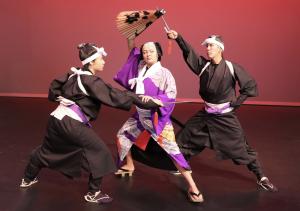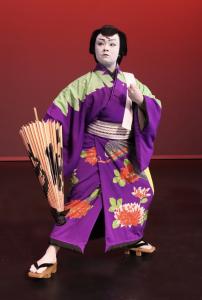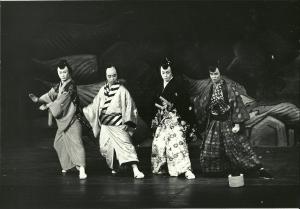ICYMI: 100 years of Hawaiʻi Kabuki in English: Masters from Japan train UH actors
University of Hawaiʻi at MānoaOperations Coordinator, Kennedy Theatre
Jessica Jacob
Manager, Kennedy Theatre
Link to video and sound (details below): https://go.hawaii.edu/XGn
Hawaiʻi’s long history with kabuki stretches back to the 19th century when crowds flocked to watch traveling troupes perform the traditional Japanese theatre art form known for its ornately decorated costumes and eye-catching makeup. 2024 marks the centennial anniversary of the first known English-language kabuki ever performed in Hawaiʻi, which started at the University of Hawaiʻi at Mānoa. The very first on-campus production debuted in November 1924, and to mark the milestone, master kabuki artists from Japan are mentoring UH Mānoa students for the premiere of The Maiden Benten and the Bandits of the White Waves next April at Kennedy Theatre.
“They are the masters, so it is absolutely critical that students learn directly from the source rather than through videos and secondhand information,” said Julie Iezzi, a theatre professor at UH Mānoa who is overseeing the upcoming production. “We’re really fortunate that actors are willing to come here and work so diligently and for so long with our students.”
Master class
This spring, the UH Mānoa Department of Theatre and Dance invited award-winning kabuki actor Monnosuke Ichikawa VIII and his two apprentices, Utaki Ichikawa and Takishō Ichikawa (all three are apart of the same ʻacting family’) to train UH Mānoa students on-campus. Born into one of the oldest acting lineages in kabuki theatre, Monnosuke Ichikawa is an eighth-generation actor within a familial line that can trace its Japanese kabuki roots to 1713.
“Something that I would like students to learn from this kabuki project is, first of all, the charm and appeal of kabuki as an artform. It is often said that meaningful experiences nurture budding aspirations, so I want them to get that from this process,” Ichikawa expressed through an interpreter.
Kabuki: The Five Bandits
The upcoming UH Mānoa production, also commonly known as Benten Kozō, depicts five distinctive thieves with a mastery of masquerade and captures schemes and back stories that lead to shocking revelations, surprising reunions and startling twists. The 40-member cast will perform the play in English, however Ichikawa tasked them with learning it in Japanese first in an effort to grasp the proper tone and rhythm customarily heard in kabuki theatre.
Ticket prices range $8–$25 for the production set to open April 19, 20, 26 and 27 at 7:30 p.m. and April 28 at 2 p.m.
Audiences will see UH Mānoa actress Karese Kaw-uh on stage; the MFA theatre for youth student garnered one of the play’s starring roles. The 27-year-old is grateful for the opportunity to study her craft alongside respected actors from Japan.
“To be able to learn from them in this capacity, it’s nothing like I would have ever experienced elsewhere before. It’s a little nerve racking but also more than that, it’s just this chance to grow,” said Kaw-uh who made the move to Hawaiʻi after learning about UH Mānoa’s internationally-recognized Asian theatre program.
Lessons on and off-stage
In preparation for this production, which was postponed during the COVID-19 pandemic, the theatre and dance department has provided opportunities for students since 2019 to work with other specialists from Japan and Hawaiʻi who focused on a wide-range of facets related to kabuki from costume, makeup, wig styling, set design and music accompaniment.
Guest artist Kineya Sakio, an accomplished Honolulu-born shamisen (traditional Japanese three-stringed-instrument) musician, is working with students and faculty from UH Mānoa who will play in the kabuki production’s live ensemble.
Full-circle
Benten Kozō is especially nostalgic for Kennedy Theatre, which is celebrating its 60th season. It’s the same kabuki play that opened the theatre’s doors on December 4, 1963. The 619-seat mainstage theatre at UH Mānoa is the only theatre in the U.S. designed with removable seats to accommodate a hanamichi, a stage extension kabuki actors use for notable entrances and exits during performances.
In January, Iezzi will unveil a historical exhibit, Kabuki in Hawaiʻi: Through Time and Space, at the East-West Center Gallery. Spectators will be transported on a visual and auditory journey through 130 years of kabuki in Hawaiʻi. According to records, the first known documented kabuki performance in the islands was as early as 1893.
B-ROLL: (2 minutes, 3 seconds)
:00-:40 Kabuki masters train UH Mānoa students
:41-:53 UH Mānoa student Karese Kaw-uh rehearsing
:54-1:01 UH Mānoa student Karese Kaw-uh full costume
1:02-1:17 more training with kabuki masters
1:18-1:26 rehearsal in full costume
1:27-1:35 Clip from 1970 UH kabuki production
1:35-2:03 vintage photos from Kennedy Theatre 1963 grand opening
SOUNDBITES:
Julie Iezzi, Professor/UH Mānoa Department of Theatre and Dance
(pronunciation guide: Yet-See)
(10 seconds)
“They are the masters so it is absolutely critical that students learn directly from the source rather than through videos and secondhand information.”
Karese Kaw-uh, Student/UH Mānoa Department of Theatre and Dance (pronunciation guide: Kuh-Reese Cow-Woo)
(15 seconds)
“So to be able to learn from them in this capacity it’s nothing like I would ever experience elsewhere before. It’s a little nerve-racking but also more than that it’s just this chance to grow.”



